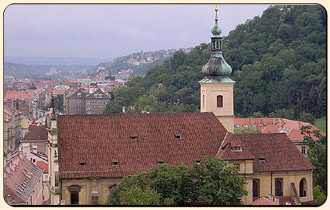 |
 |
 |
| |
Prague - The Lesser Town
(the Lesser Quarter, Mala
Strana)
The Lesser Town was founded in 1257
by King Premysl Otakar II, as the second town of Prague after the
Old Town. The lesser
Town is,
without exaggeration, the pearl of the Baroque style. Just as the
church of St Nicholas is the pride of the Lesser Town, so the Lesser
Town is the pride of Prague.

Wallenstein Pallace and Gardens Wallenstein Street leads to the Lesser Town Square. Currently
there are embassies and expensive residences in this street.
On the left we see the Wallenstein Palace and Gardens. The
Wallenstein Palace houses the Senate of the Czech Republic.
This most magnificent of Prague´s noble residences and
one of the first Baroque palaces in Prague, was built in 1624-1630
for Albrecht of Wallenstein. The palace is closed off from
the surrounding world and concentrated around an architecturally
designed garden. The most valuable structure is the Italian
Sala Terrena (garden pavillion), designed in the style of the
late Renaissance and dominating the palace garden. The garden
is closed by the Riding-school of Wallenstein Palace, a building
from 1630. |

St. Nicholas Church After walking around the palaces of aristocratic families,
we arrive at the original market-place of the Lesser Town,
now the Lesser Town Square. The area of the square is divided
into two unequal parts and the whole of the left-bank part
of the historic core of Prague is dominated by a building with
a characteristic dome, the symbol of Prague Baroque. St. Nicholas
Church is a monumental Baroque building, standing on the site
of a demolished Gothic church of the same name. It was constructed
by three generations of the finest Baroque architects of Prague.
The main architects were the Dientzenhofers, father and son. |

Nerudova Street
Nerudova Street is one of the most beautiful streets in Prague,
named after the famous Czech poet and journalist, Jan Neruda,
who lived in the houses called 'At the Three Black Eagles'
and 'At the Two Suns' (pictured). The street was once the main
road to Prague Castle. Nowadays, many of the old houses are
home
to
coffee houses, wine bars and pubs. |

The Church of Our Lady Victorious Inside the church is the Prague Child Jesus (Bambino di Praga).
This little wax statue has made the Church of Our Lady Victorious
world-famous. It was brought from Spain at the end of the 16th
century and, in 1628, Lady Polyxena of Lobkowicz gave it to
the Carmelites. The Child Jesus has many changes of costume
throughout the year, donated by individuals and organizations
from all over the world. It is still much revered. |
 Kampa Island
A romantic island, Kampa is separated from the Lesser Town
by the branch of the Vltava River called the Devil´s
Stream (Certovka). Originally there were only gardens on the
island. Today it is a cherished and elegant part of Prague
with a village-like character and large public picnic lawn. |
 |
|
|
 |
 |
 |









